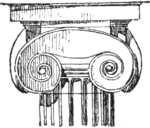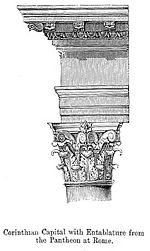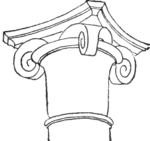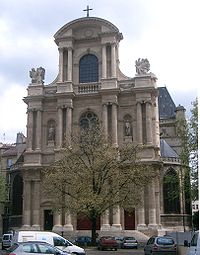- Classical order
-
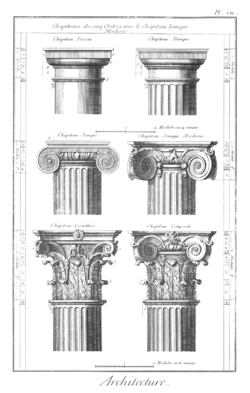 An illustration of the five orders engraved for the Encyclopédie, vol. 18, showing the Tuscan and Doric orders (top row); two versions of the Ionic order (center row); Corinthian and Composite orders (bottom row).
An illustration of the five orders engraved for the Encyclopédie, vol. 18, showing the Tuscan and Doric orders (top row); two versions of the Ionic order (center row); Corinthian and Composite orders (bottom row).
A classical order is one of the ancient styles of classical architecture, each distinguished by its proportions and characteristic profiles and details, and most readily recognizable by the type of column employed. Three ancient orders of architecture—the Doric, Ionic, and Corinthian—originated in Greece. To these the Romans added the Tuscan, which they made simpler than Doric, and the Composite, which was more ornamental than the Corinthian. The order of a classical building is akin to the mode or key of classical music, the grammar or rhetoric of a written composition. It is established by certain modules like the intervals of music, and it raises certain expectations in an audience attuned to its language.
Contents
Elements
Each style has distinctive capitals and entablatures. The shaft is sometimes articulated with vertical hollow grooves known as fluting. The shaft is wider at the bottom than at the top, because its entasis, beginning a third of the way up, imperceptibly makes the column slightly more slender at the top.
 Table of architecture, Cyclopaedia, 1728
Table of architecture, Cyclopaedia, 1728
The capital rests on the shaft. It has a load-bearing function, which concentrates the weight of the entablature on the supportive column, but it primarily serves an aesthetic purpose. The necking is the continuation of the shaft, but is visually separated by one or many grooves. The echinus lies atop the necking. It is a circular block that bulges outwards towards the top to support the abacus, which is a square or shaped block that in turn supports the entablature. The entablature consists of three horizontal layers, all of which are visually separated from each other using moldings or bands. In Roman and post-Renaissance work, the entablature may be carried from column to column in the form of an arch that springs from the column that bears its weight, retaining its divisions and sculptural enrichment, if any.
Measurement
The height of columns are calculated in terms of a ratio between the diameter of the shaft at its base and the height of the column. A Doric column can be described as seven diameters high, an Ionic column as eight diameters high and a Corinthian column nine diameters high. Sometimes this is phrased as "lower diameters high", to establish which part of the shaft has been measured.
Greek orders
There are three distinct orders in Ancient Greek architecture: Doric, Ionic, and, later, Corinthian. These three were adopted by the Romans, who modified their capitals. The Roman adoption of the Greek orders took place in the 1st century BC. The three Ancient Greek orders have since been consistently used in neo-classical European architecture.
Sometimes the Doric order is considered the earliest order, but there is no evidence to support this. Rather, the Doric and Ionic orders seem to have appeared at around the same time, the Ionic in eastern Greece and the Doric in the west and mainland.
Both the Doric and the Ionic order appear to have originated in wood. The Temple of Hera in Olympia is the oldest well-preserved temple of Doric architecture. It was built just after 600 BC. The Doric order later spread across Greece and into Sicily where it was the chief order for monumental architecture for 800 years.
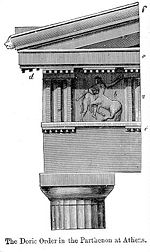 The Doric order of the Parthenon
The Doric order of the Parthenon
Doric order
Main article: Doric orderThe Doric order originated on the mainland and western Greece. It is the simplest of the orders, characterized by short, faceted, heavy columns with plain, round capitals (tops) and no base. With a height that is only four to eight times its diameter, the columns are the most squat of all orders. The shaft of the Doric order is channeled with 20 flutes. The capital consists of a necking which is of a simple form. The echinus is convex and the abacus is square.
Above the capital is a square abacus connecting the capital to the entablature. The Entablature is divided into three horizontal registers, the lower part of which is either smooth or divided by horizontal lines. The upper half is distinctive for the Doric order. The frieze of the Doric entablature is divided into triglyphs and metopes. A triglyph is a unit consisting of three vertical bands which are separated by grooves. Metopes are plain or carved reliefs.
The Greek forms of the Doric order come without an individual base. They instead are placed directly on the stylobate. Later forms, however, came with the conventional base consisting of a plinth and a torus. The Roman versions of the Doric order have smaller proportions. As a result they appear lighter than the Greek orders.
Ionic order
Main article: Ionic orderThe Ionic order came from eastern Greece, where its origins are entwined with the similar but little known Aeolic order. It is distinguished by slender, fluted pillars with a large base and two opposed volutes (also called scrolls) in the echinus of the capital. The echinus itself is decorated with an egg-and-dart motif. The Ionic shaft comes with four more flutes than the Doric counterpart (totalling 24). The Ionic base has two convex moldings called tori which are separated by a scotia.
The Ionic order is also marked by an entasis, a curved tapering in the column shaft. A column of the ionic order is nine or lower diameters. The shaft itself is eight diameters high. The architrave of the entablature commonly consists of three stepped bands (fasciae). The frieze comes without the Doric triglyph and metope. The frieze sometimes comes with a continuous ornament such as carved figures.
Corinthian order
Main article: Corinthian orderThe Corinthian order is the most ornate of the Greek orders, characterized by a slender fluted column having an ornate capital decorated with two rows of acanthus leaves and four scrolls. It is commonly regarded as the most elegant of the three orders. The shaft of the Corinthian order has 24 flutes. The column is commonly ten diameters high.
The Roman writer Vitruvius credited the invention of the Corinthian order to Callimachus, a Greek sculptor of the 5th century BCE. The oldest known building built according to this order is the Choragic Monument of Lysicrates in Athens, constructed from 335 to 334 BCE. The Corinthian order was raised to rank by the writings of Vitruvius in the 1st century BC.
Roman orders
The Romans adapted all the Greek orders and also developed two orders of their own, basically modification of Greek orders. The Romans also invented the superposed order. A superposed order is when successive stories of a building have different orders. The heaviest orders were at the bottom, whilst the lightest came at the top. This means that the Doric order was the order of the ground floor, the Ionic order was used for the middle story, while the Corinthian or the Composite order was used for the top story.
The Colossal order was invented by architects in the Renaissance. The Colossal order is characterized by columns that extend the height of two or more stories.
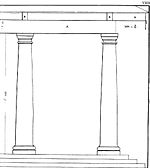 The Tuscan order in Andrea Palladio, Quattro Libri di Architettura, 1570
The Tuscan order in Andrea Palladio, Quattro Libri di Architettura, 1570
Tuscan order
Main article: Tuscan orderThe Tuscan order has a very plain design, with a plain shaft, and a simple capital, base, and frieze. It is a simplified adaptation of the Doric order by the Romans. The Tuscan order is characterized by an unfluted shaft and a capital that only consist of an echinus and an abacus. In proportions it is similar to the Doric order, but overall it is significantly plainer. The column is normally seven diameters high. Compared to the other orders, the Tuscan order looks the most solid.
Composite order
Main article: Composite orderThe Composite order is a mixed order, combining the volutes of the Ionic with the leaves of the Corinthian order. Until the Renaissance it was not ranked as a separate order. Instead it was considered as a late Roman form of the Corinthian order. The column of the Composite order is ten diameters high.
Historical development of the orders
The St-Gervais-et-St-Protais Church in Paris presents columns of the three orders : doric at the ground floor, ionic at the second floor, corinthian at the third floor
The Renaissance period saw renewed interest in the ruins left by the ancient cultures of Greece and Rome, and the fertile development of a new architecture based on classical principles. The handbook De architectura by Roman writer, architect and engineer Vitruvius, is the only architectural writing that survived from Antiquity. Rediscovered in the 15th century, Vitruvius was instantly hailed as the authority on classical orders and on architecture in general.
Architects of the Renaissance and the Baroque periods in Europe based their rules on Vitruvius' writings. What was added were rules for the use of the classical orders, and the exact proportions of the orders down to the most minute detail. Commentary on the appropriateness of the orders for temples devoted to particular deities (Vitruvius I.2.5) were elaborated by Renaissance theorists, with Doric characterized as bold and manly, Ionic as matronly, and Corinthian as maidenly.[1]
Vignola's orders
Main article: The Five Orders of ArchitectureFollowing the examples of Vitruvius and the five books of the Regole generali d'architettura by Sebastiano Serlio, published from 1537 onwards, Giacomo Barozzi da Vignola produced an architecture rule book that was more practical than the previous two books, which were more philosophical in nature, his Cinque ordini di erchitettura (The Five Orders of Architecture ) from 1562; the book is considered "one of the most successful architectural textbooks ever written",[2] despite having no text apart from the notes and the introduction.[3] The book consisted simply of an introduction followed by 32 annotated plates, with views from the Pantheon illustrating the Corinthian order and the Theatre of Marcellus for the Doric order. Later editions had more illustrations. By 1700, it had been reprinted 15 times in Italian, and was translated in Dutch, English, French, German, Russian and Spanish.[4]
Each period interpreted the orders in their own way. The architecture of every subsequent period of European architecture was based on the classical orders. In the later 18th century the rules of the Renaissance and the Baroque periods came to be disregarded, and the original use of the orders revived, based on first-hand study of the ruins of classical antiquity - often hailed as the 'correct' use of the orders.
In America, The American Builder's Companion,[5] written in the early 19th century by the architect Asher Benjamin, influenced many builders in the eastern states, particularly those who developed what became known as the Federal style.
The break from the classical mode came first with the Gothic revival, then the development of modernism during the 19th century. The Bauhaus promoted pure functionalism, stripped of superfluous ornament, and that has become one of the defining characteristics of modern architecture. There are some exceptions. Postmodernism introduced an ironic use of the orders as a cultural reference, divorced from the strict rules of composition. On the other hand, a few practitioners e.g. Quinlan Terry still work in a traditional classical idiom.
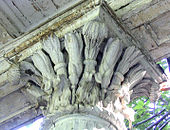 Corn capital at the Litchfield Villa Prospect Park (Brooklyn) (A.J. Davis, architect)
Corn capital at the Litchfield Villa Prospect Park (Brooklyn) (A.J. Davis, architect)
Nonce orders
Several orders, usually based upon the composite order and only varying in the design of the capitals, have been invented under the inspiration of specific occasions, but have not been used again. Thus they may be termed "nonce orders" on the analogy of nonce words. Robert Adam's brother James was in Rome in 1762, drawing antiquities under the direction of Clérisseau; he invented a British Order, of which his ink-and-wash rendering with red highlighting, is at the Avery Library, Columbia University. Adam published an engraving of it. In its capital the heraldic lion and unicorn take the place of the Composite's volutes, a Byzantine/Romanesque conception, but expressed in terms of neoclassical realism. In 1789 George Dance invented an Ammonite Order, a variant of Ionic substituting volutes in the form of fossil ammonites for John Boydell's Shakespeare Gallery in Pall Mall, London.
In the United States Benjamin Latrobe, the architect of the Capitol building in Washington DC, designed a series of botanically American orders. Most famous is the order substituting corncobs and their husks, which was executed by Giuseppe Franzoni and employed in the small domed Vestibule of the Supreme Court. Only the Supreme Court survived the fire of August 24, 1814, nearly intact. With peace restored, Latrobe designed an American order that substituted for the acanthus tobacco leaves, of which he sent a sketch to Thomas Jefferson in a letter, November 5, 1816. He was encouraged to send a model of it, which remains at Monticello. In the 1830s Alexander Jackson Davis admired it enough to make a drawing of it. In 1809 Latrobe invented a second American order, employing magnolia flowers contrained within the profile of classical mouldings, as his drawing demonstrates. It was intended for "the Upper Columns in the Gallery of the Entrance of the Chamber of the Senate" (United States Capitol exhibit).
These nonce orders all express the "speaking architecture" (architecture parlante) that was taught in the Paris courses, most explicitly by Étienne-Louis Boullée, in which sculptural details of classical architecture could be enlisted to speak symbolically, the better to express the purpose of the structure and enrich its visual meaning with specific appropriateness. This idea was taken up strongly in the training of Beaux-Arts architecture, ca 1875-1915: see architecture parlante.
See also
- Temple (Greek)
- Temple (Roman)
- De architectura by Vitruvius
- Five Orders of Periwigs
References
- ^ Julian Small, "The five orders of classical architecture".
- ^ Evers, Vernd (2003). Architectural theory: from the Renaissance to the present. Taschen. pp. 845. ISBN 9783822816998. http://books.google.com/books?id=V5OK-Yw-A3cC&pg=PA86&dq=Vignola+%22Five+Orders%22#v=onepage&q=Vignola%20%22Five%20Orders%22&f=false.
- ^ Summerson, John (1963). The classical language of architecture. MIT Press. pp. 56. ISBN 9780262690126. http://books.google.com/books?id=57aoJE26kQkC&pg=PA54&dq=Vignola+%22no+text%22+orders#v=onepage&q=Vignola%20%22no%20text%22%20orders&f=false.
- ^ Ware, William R. (1994). The American Vignola: a guide to the making of classical architecture. Courier Dover Publications. pp. 160. ISBN 9780486283104. http://books.google.com/books?id=nV3eiQFnwyAC&pg=PR13&dq=Vignola+%22Five+Orders%22#v=onepage&q=Vignola%20%22Five%20Orders%22&f=false.
- ^ Asher Benjamin, The American Builder's Companion, Dover edition: ISBN 0-486-22236-5. Based on the 1827 6th edition, 70 plates with many architectural details and instructions regarding proportion.
Further reading
- Barletta, Barbara A., The Origins of the Greek Architectural Orders (Cambridge University Press) 2001
- Chitham, Robert, The classical orders of architecture (2nd edition), Oxford: Architectural Press, 2005, ISBN 0750661240
- Curl, James Stevens, Classical Architecture: An Introduction to Its Vocabulary and Essentials, with a Select Glossary of Terms 2003. ISBN 0-393-73119-7
- Summerson, Sir John, The Classical Language of Architecture MIT Press, 1966. ISBN 0-262-69012-8 (developed from a set of BBC radio talks).
- Tzonis, Alexander, Classical Architecture: The Poetics of Order 1986 ISBN 0-262-70031-X
- Gromort, Georges (Author); Richard Sammons (Introductory Essay). The Elements of Classical Architecture (Classical America Series in Art and Architecture), W. W. Norton & Co., 2001, ISBN 0393730514
Other orders Categories:- Architectural history
- Orders of columns
- Ancient Roman architectural elements
- Ancient Greek architecture
- Classical architecture
- Neoclassical architecture
- Design history
Wikimedia Foundation. 2010.

